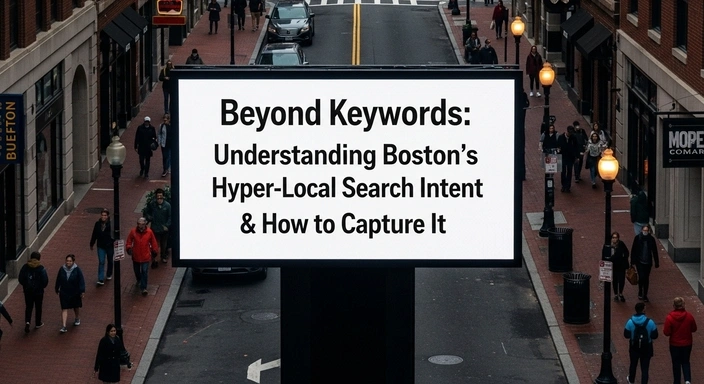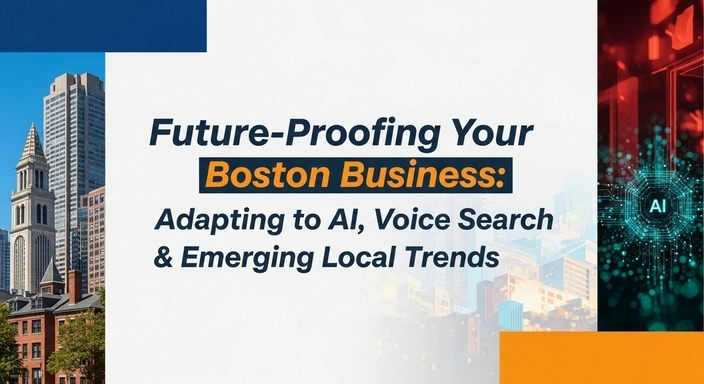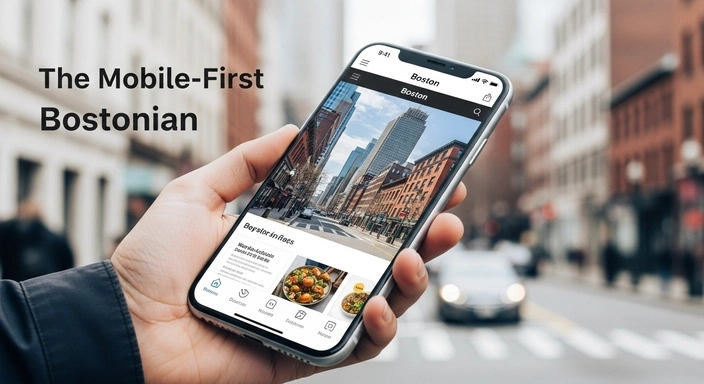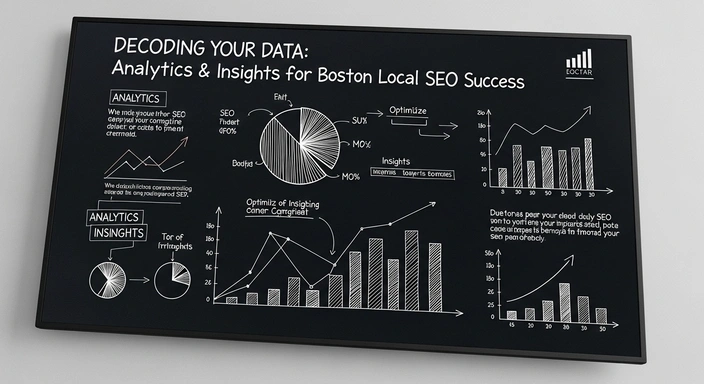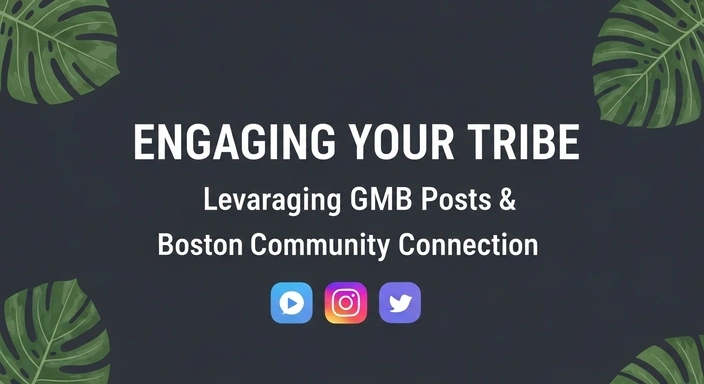This article is the third in our 12-part series: Beyond the Boom: How Boston Businesses Can Dominate Local Search & Drive Foot Traffic in a Shifting Economy. If you missed the previous essential guides, catch up on The New Reality: Why Local Search is Non-Negotiable for Boston Businesses in 2025 and Your Digital Storefront: Optimizing Your Google Business Profile for Boston Domination. Discover the full series here.
In our journey to equip Boston businesses for digital dominance in 2025, we’ve firmly established the critical imperative of local search and meticulously detailed the power of an optimized Google Business Profile. Yet, merely having a strong online presence is only half the battle. The true mastery of local SEO lies in understanding something far more nuanced than simple keywords: it’s about discerning and fulfilling **hyper-local search intent**.
Think about how Bostonians navigate their city and their needs. A resident in Southie isn’t just looking for “pizza”; they’re searching for “best thin-crust pizza in South Boston open late.” A visitor in the Financial District isn’t just looking for “coffee”; they need “a quiet coffee shop with WiFi near State Street for a meeting.” The subtle addition of “best,” “open late,” “thin-crust,” “quiet,” or a specific landmark transforms a generic query into a precise expression of intent, revealing the user’s immediate need, context, and desired outcome.
Google’s algorithms, powered by advanced Artificial Intelligence (AI) models like MUM (Multitask Unified Model) and Gemini, are no longer simply matching keywords. They are interpreting the complex, often implied, meaning behind every search query. They understand context, user location, time of day, historical behavior, and the underlying *reason* for the search. For Boston businesses, this means your content and digital presence must go “beyond keywords” to genuinely understand and address the specific intent of your local audience. This is the difference between simply being found and being **chosen**.
This comprehensive guide will deep dive into the intricacies of hyper-local search intent. We’ll explore how Google’s cutting-edge AI interprets these complex queries, how to uncover the precise language your Boston customers are using, and, most critically, how to craft a digital presence — from your website to your Google Business Profile — that perfectly aligns with and fulfills that intent, ensuring you capture high-value customers in Boston’s dynamic 2025 market.
—
The Evolution of Search: Why Intent Trumps Keywords in 2025

For years, SEO was largely about keywords: identifying popular terms and stuffing them into content. While keywords remain a fundamental signal, Google’s sophistication has rendered this simplistic approach obsolete. In 2025, the algorithm’s primary goal is to understand and satisfy **user intent** — the underlying goal or need behind a user’s query.
From Keywords to Meaning: Google’s AI Revolution
Google’s journey from a keyword-matching engine to a semantic understanding powerhouse has been driven by successive AI advancements:
- Hummingbird (2013): Moved from keywords to understanding the meaning behind entire phrases.
- RankBrain (2015): An AI system that interprets ambiguous queries and improves search results over time, particularly for novel queries.
- BERT (Bidirectional Encoder Representations from Transformers, 2019): Enhanced Google’s understanding of natural language, recognizing the nuances of context and relationships between words in a query. This was a massive leap for conversational searches.
- MUM (Multitask Unified Model, 2021 onwards): A transformative AI model far more powerful than BERT. MUM can understand and generate language, interpret information across different modalities (text, images, video), and comprehend complex, multi-faceted questions. This allows Google to answer queries for which there isn’t a direct pre-existing answer and to surface more relevant results from various sources. For local search, MUM’s ability to understand context across different signals is invaluable.
- Gemini (2023 onwards): Google’s most capable and general AI model, designed to be multimodal from the ground up. Gemini further enhances MUM’s capabilities, allowing Google to understand even more complex queries, synthesize information across diverse formats, and provide highly relevant, nuanced answers directly. This means Google understands user intent with unprecedented precision.
- Search Generative Experience (SGE) & AI Overviews (2024-2025): Google’s integration of generative AI directly into the search results page means that for many queries, users now receive AI-generated summaries (AI Overviews) and suggested follow-up questions. This directly influences the “zero-click” phenomenon we discussed in Post 2, making it crucial for your content to be seen as an authoritative “information building block” for AI responses. SGE’s goal is to provide comprehensive answers without users needing to click multiple links.
For Boston businesses, this means Google isn’t just looking for “Boston plumber” on your page. It’s trying to understand if your content truly addresses the underlying need of someone typing “water heater repair emergency Back Bay” — their urgency, their location, and the specific problem they’re facing.
Why User Experience (UX) is Now an Intent Signal
Beyond the words themselves, Google’s algorithms (like Core Web Vitals, including Interaction to Next Paint (INP)) now heavily scrutinize user experience. A fast, stable, and responsive website signals that you value the user’s time and are committed to providing a seamless experience — which directly fulfills intent. If a user clicks your link but finds a slow-loading, frustrating site, Google’s AI will learn from that negative signal.
—
The Spectrum of Local Search Intent: Decoding Bostonian Needs

To capture hyper-local intent, we first need to categorize the different types of needs a Bostonian might express in a search query. While broad categories exist, we’ll refine them for the local context:
1. Informational Local Intent: “What, Where, Why, How To”
These queries seek answers or information about a local topic, event, service, or landmark. The user is in a learning phase.
- Examples:
- “What are the best dog parks in Cambridge?” (seeking information about local amenities)
- “How to get a Boston library card for non-residents?” (seeking a process)
- “History of Faneuil Hall Boston” (seeking historical facts)
- “Best time to visit Boston Public Garden for flowers” (seeking specific local advice)
- User’s Goal: To gain knowledge, understand a concept, or find details about a local subject. They are not necessarily ready to buy but are exploring.
- Business Opportunity: Position your business as a local authority and resource. Provide valuable, comprehensive content that answers their questions thoroughly. This builds trust and top-of-funnel brand awareness.
2. Navigational Local Intent: “Find My Way To”
The user wants to find a specific local business or location. They likely know the name but need directions, hours, or contact information.
- Examples:
- “Boston Children’s Hospital address”
- “Hours for Flour Bakery Fort Point”
- “Directions to TD Garden Boston”
- “Contact number for Boston Public Library”
- User’s Goal: To reach a known destination or find its immediate contact details.
- Business Opportunity: Your Google Business Profile (GBP) is paramount here. Ensure exact NAP (Name, Address, Phone) consistency across all platforms. A fully optimized GBP with accurate hours, updated contact info, and clear direction links will capture these users directly.
3. Transactional Local Intent: “I Want to Buy/Do It Now”
The user is ready to make a purchase, book a service, or perform a specific action locally. This is the highest-value intent for direct conversion.
- Examples:
- “Pizza delivery Southie open now”
- “Hair salon Boston Common online booking”
- “Emergency plumber Beacon Hill”
- “Buy Red Sox tickets Fenway Park”
- “Vegan bakery near me with online ordering”
- User’s Goal: To complete a transaction or task immediately.
- Business Opportunity: Optimize for direct calls to action (CTAs). Ensure online booking, ordering, or contact forms are prominent and frictionless. Use specific transactional keywords with local modifiers. Your GBP’s “Call” or “Order” buttons are crucial.
4. Commercial Investigation Local Intent: “Compare Before I Buy”
The user is researching a product or service with the intent to purchase soon, but they need to compare options, read reviews, or gather more information before committing.
- Examples:
- “Best personal injury lawyers Boston reviews”
- “Top rated sushi restaurants Back Bay”
- “Cost of movers from Cambridge to Somerville”
- “Commercial real estate agents Seaport Boston”
- “Dentist near me accepting new patients”
- User’s Goal: To evaluate options and make an informed decision about a local product or service.
- Business Opportunity: Provide detailed product/service pages, comparison guides, transparent pricing information (if applicable), and most importantly, showcase positive customer reviews and testimonials. Content that compares your offering to competitors (ethically and factually) or highlights your unique value proposition is key.
Understanding these distinct intents allows you to tailor your content and optimization efforts to match the user’s specific stage in their buying journey, moving them efficiently from query to conversion.
—
Uncovering Hyper-Local Keywords & Phrases: Listening to Boston’s Voice
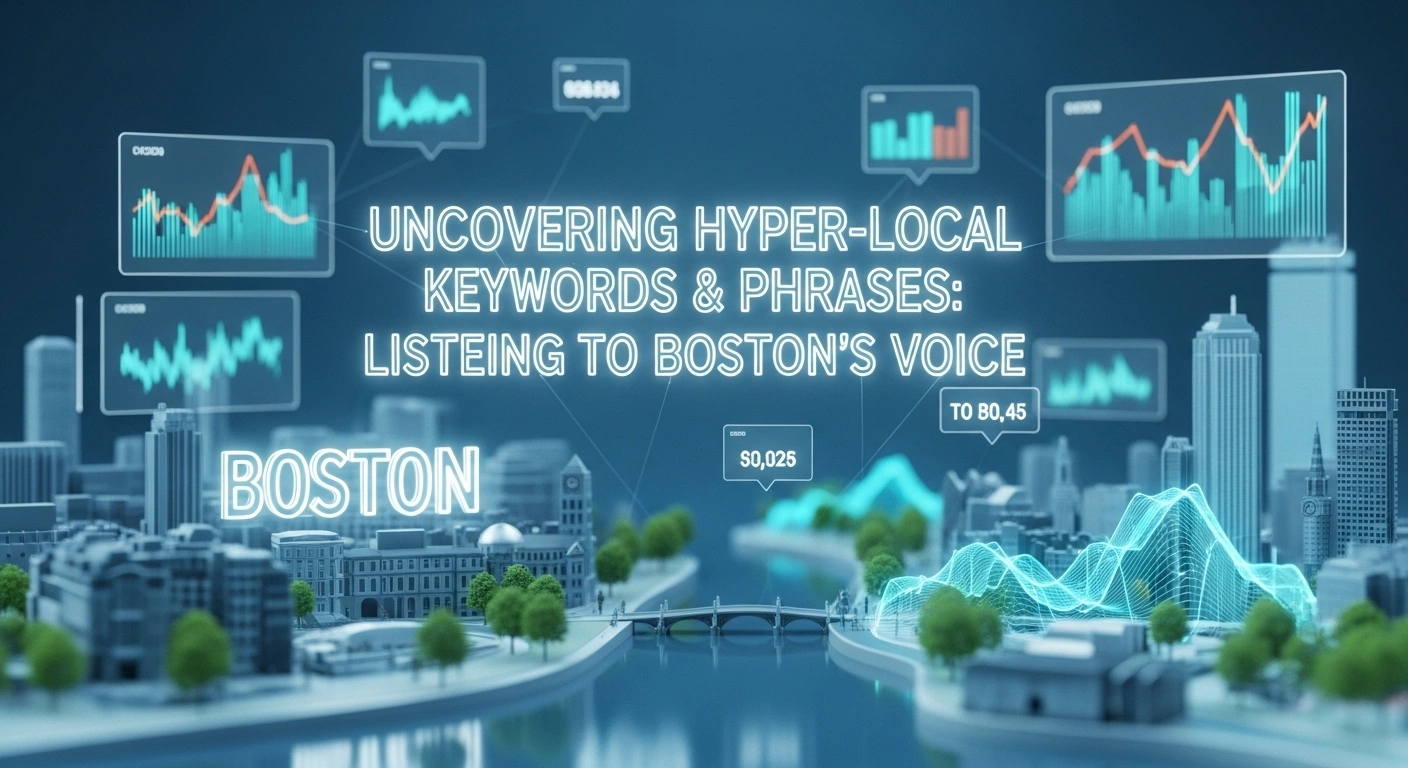
The first step in fulfilling intent is understanding the precise language your target customers are using. This goes far beyond generic keywords and requires a blend of traditional SEO tools, Google’s insights, and a deep understanding of local Bostonian vernacular.
1. Traditional Keyword Research Tools with a Local Twist
Leverage tools like Semrush, Ahrefs, Moz Keyword Explorer, and Google Keyword Planner. However, don’t just look for high-volume national terms. Filter your results by “Boston,” “Massachusetts,” and specific neighborhoods.
- Geo-Modifiers: Always integrate city names (Boston, Cambridge, Somerville), specific neighborhoods (North End, Southie, Back Bay, Seaport, Allston, Jamaica Plain, Dorchester, Beacon Hill, Financial District, Kenmore Square), landmarks (TD Garden, Fenway Park, Boston Common, Public Garden, Freedom Trail), and even zip codes (e.g., “02108 lawyer”).
- Long-Tail Keywords: These are longer, more specific phrases that reveal greater intent. While they have lower search volume individually, they often have higher conversion rates. (e.g., “affordable vegan bakery near Harvard Square,” “24-hour urgent care clinic Brighton”).
- “Near Me” & “Open Now” Variations: Explicitly research and integrate these phrases. Google understands them implicitly, but using them in your content and GBP descriptions reinforces relevance.
2. Google Business Profile Insights: Your Goldmine of Real Search Queries
Your GBP dashboard’s “Insights” section provides invaluable data on the *actual search queries* that led customers to your business. This is direct feedback from Google on what terms people are using to find you.
- Analyze “Search Queries”: Look for unexpected keywords, variations, and long-tail phrases. These are the organic terms that are already working for you.
- Identify Gaps: If you’re missing out on key terms you *should* be ranking for, it highlights opportunities for content creation or GBP optimization.
3. Google Autocomplete & “People Also Ask” (PAA) Sections
These are direct windows into Google’s understanding of user intent and related queries:
- Autocomplete: Start typing a local query (e.g., “best pizza Boston”) and see Google’s suggestions. These are often highly searched terms.
- “People Also Ask”: For any given search, the PAA box provides related questions users are asking. These are perfect for generating informational content that directly answers common queries.
4. Review Analysis: Mining Customer Language for Intent Signals
Customers use natural language in reviews. Analyzing reviews for common phrases, pain points, and specific needs can reveal powerful intent signals. If many customers praise your “quick service” or “friendly staff” for “emergency plumbing in Beacon Hill,” these phrases are valuable for your content.
5. Competitor Analysis: Learning from the Leaders
Analyze the websites and GBPs of your top local competitors. What keywords are they ranking for? What content are they producing? What categories and attributes are they using? This can reveal missed opportunities and effective strategies.
6. Localized Forums, Social Media Groups, and Community Pages
Monitor local Boston Facebook groups, Reddit threads (e.g., r/boston, r/somerville), neighborhood associations’ forums, and platforms like Nextdoor. What questions are residents asking? What problems are they discussing? This provides genuine, real-world insights into local needs and intent.
7. Google Trends (Localized)
Use Google Trends to see the popularity of local search terms over time. Compare different neighborhoods or service types to identify emerging trends or seasonal fluctuations in intent.
—
Crafting Content for Hyper-Local Intent: The Bostonian Approach

Once you understand the intent behind Bostonian search queries, the next critical step is to create content that precisely fulfills that intent. This means tailoring your website content, blog posts, and Google Business Profile to provide comprehensive, satisfying answers.
1. Website Content: Your Intent-Driven Hub
A. Service Area Pages: Precision for Distributed Businesses
If your business serves multiple Boston neighborhoods or the broader Greater Boston area (but doesn’t have a physical location in each), dedicated service area pages are crucial. These should be rich with content tailored to that specific location’s needs:
- Unique Content: Don’t just duplicate content. Write unique introductions, discuss specific challenges or needs of that neighborhood (e.g., “Plumbing services for historic homes in Beacon Hill”), and highlight local testimonials.
- Local Keywords: Naturally integrate the neighborhood’s name and relevant services throughout the page (e.g., “South Boston Electrical Repair,” “Jamaica Plain HVAC Installation”).
- Local Citations: Include mentions of local landmarks, parks, or community centers to reinforce geographical relevance.
- Schema Markup: Implement Local Business Schema tailored to each service area, specifying the `areaServed` property.
B. Product/Service Pages: Answering the “What Do You Offer?” Intent
Ensure each product or service you offer has its own dedicated page. These pages should be meticulously optimized to address transactional and commercial investigation intent:
- Detailed Descriptions: Provide comprehensive information about what you offer, how it benefits the customer, and what sets it apart.
- Pricing Information: If applicable, provide clear pricing or a way to get a quote. Transparency builds trust.
- Reviews & Testimonials: Integrate product/service-specific reviews (with schema markup).
- Clear CTAs: Make it effortless for users to “Buy Now,” “Book Service,” “Request a Quote,” or “Call Us.”
- Comparison Content: For commercial investigation intent, consider dedicated pages comparing your services or products to common alternatives, highlighting your competitive advantages.
C. Local Blog Content: Fulfilling Informational Intent & Building Authority
Your blog is your primary tool for addressing informational intent and establishing your business as a local expert. The goal is to provide valuable, free resources that answer common questions posed by Bostonians.
- “Best Of” Guides: “Best Coffee Shops in Cambridge,” “Top Pizzerias in the North End,” “Best Boutiques on Newbury Street.”
- Local How-To Guides: “How to Find Affordable Parking in Downtown Boston,” “Guide to Navigating the MBTA for First-Time Visitors,” “Tips for Renovating a Brownstone in Back Bay.”
- Local Event Calendars/Guides: If relevant to your business, curate information on local festivals, concerts, or community gatherings.
- Community Spotlights: Feature other local businesses, non-profits, or community leaders. This builds local connections and can lead to valuable backlinks.
- Solve Local Pain Points: Address common problems faced by Boston residents (e.g., “Dealing with Basement Flooding in Historic Boston Homes”).
Remember, content for informational intent may not convert immediately, but it builds trust, establishes authority (E-E-A-T), and keeps your brand top-of-mind when the user is ready to make a transactional decision.
D. FAQs & Knowledge Bases: Direct Answers for AI & Users
A comprehensive FAQ section or knowledge base on your website is invaluable for addressing common questions directly and providing structured data for Google’s AI. This helps fulfill both informational and commercial investigation intent.
- Use Schema Markup: Implement FAQPage Schema to help Google understand the question-and-answer format, potentially leading to rich snippets in search results and direct answers in AI Overviews.
- Comprehensive Answers: Provide clear, concise yet thorough answers to common queries about your business, products, services, and local area.
2. On-Page Optimization: Signals for Google’s AI
Every element on your webpage should be optimized to signal hyper-local intent to Google’s sophisticated AI.
- Title Tags & Meta Descriptions: These are your first impression in the SERP. Include your primary local keyword and a strong call to action or benefit. (e.g., Title: “Best Pizza North End | Authentic Italian Slices & Delivery”)
- H1 Headings: Your main heading should clearly state the page’s topic, including local modifiers. (e.g., “Discover the Best Seafood Restaurants in Boston’s Seaport District”)
- Subheadings (H2, H3): Break down your content into digestible sections, incorporating variations of local keywords and addressing specific aspects of user intent.
- Body Content: Naturally weave in local keywords, landmarks, and conversational phrases. Use synonyms and related terms to demonstrate comprehensive understanding of the topic.
- Image Alt Text & File Names: Describe images using local keywords (e.g., `pizza-north-end-boston.jpg`, `alt=”Thin crust pizza at Regina Pizzeria North End, Boston”`).
- Internal Linking: Strategically link to other relevant local content on your site. This helps Google understand your site’s structure and topic authority, and keeps users engaged.
- Embed Google Maps: Embed a Google Map with your business location on relevant service or contact pages. This visually reinforces your local presence.
3. Google Business Profile (GBP) Optimization for Intent Fulfillment
Your meticulously optimized GBP (as discussed in Post 2) is a primary driver of intent fulfillment:
- Precise Categories: Absolutely critical for Google to understand your core offering and match it to informational and transactional queries.
- Attributes: Fill out every relevant attribute. These directly answer “I want a place with…” intent (e.g., “outdoor seating,” “wheelchair accessible,” “accepts credit cards”).
- Products/Services Section: Detail your offerings. This directly answers transactional intent and helps Google match your business to specific product/service queries.
- Google Posts: Use posts for time-sensitive transactional intent (e.g., “Weekend Brunch Special in Beacon Hill”) or informational intent (e.g., “Tips for Parking in the Financial District this Holiday Season”).
- Q&A Section: Proactively answer common questions related to transactional and informational intent.
- Messaging & Call Buttons: These facilitate direct action for transactional intent.
4. Schema Markup: Speaking Google’s Language
Schema markup (structured data) is code that helps Google better understand the content on your pages. While it doesn’t directly boost rankings, it enhances your visibility and enables rich snippets that can significantly improve click-through rates, especially for intent-driven queries.
- Local Business Schema: Essential for any local business. It explicitly tells Google your business name, address, phone number, hours, and much more.
- Product Schema: For transactional pages, provides details like price, availability, and reviews, leading to rich results.
- FAQPage Schema: For your FAQ sections, helping Google display direct answers in search results or AI Overviews.
- Review/AggregateRating Schema: Displays star ratings in search results, crucial for commercial investigation intent.
—
Google’s AI: Interpreting Boston’s Nuances and Complex Queries

The latest advancements in AI are enabling Google to understand local search intent with unprecedented depth. For Boston businesses, this means your SEO strategy must be built on genuine relevance and value, rather than just keyword density.
1. Understanding Implicit vs. Explicit Local Intent
- Explicit Intent: The user directly states their location (“plumber in Cambridge,” “restaurant near Fenway Park”).
- Implicit Intent: The user’s location is understood from their IP address, device location, or search history. If a user in the North End searches for “best Italian food,” Google knows to prioritize North End Italian restaurants.
Google’s AI (MUM, Gemini) is highly adept at discerning implicit intent, meaning you still need to optimize for it even if the user doesn’t explicitly type “Boston.”
2. The Power of Context: Beyond the Query
Google’s AI leverages vast amounts of data to understand context:
- Time of Day: A search for “coffee shop” at 7 AM will prioritize breakfast spots; at 9 PM, it might suggest cafes open late.
- Device Type: Mobile searches often imply immediate, on-the-go needs (transactional, navigational), while desktop searches might indicate deeper research (informational, commercial investigation).
- Search History: Google learns from a user’s past searches to personalize results.
- User Location: The absolute cornerstone for local search. Google uses GPS, WiFi, and IP addresses for pinpoint accuracy.
3. E-E-A-T and Intent Fulfillment: Proving Your Authority
Google’s E-E-A-T (Experience, Expertise, Authoritativeness, Trustworthiness) guidelines are more critical than ever, especially for YMYL (Your Money Your Life) topics (e.g., finance, health, law). For local businesses, E-E-A-T directly influences Google’s confidence in your ability to fulfill user intent.
- Experience: Does your content (and your GBP) show firsthand experience? Use real photos, case studies, employee bios, and testimonials that demonstrate you’ve *done* what you’re talking about. For a Boston law firm, this means showcasing local verdicts or community involvement.
- Expertise: Is your content written by or attributed to experts? This means clear author bios, credentials, and original research.
- Authoritativeness: Do other reputable sources (local news, industry associations, established Boston businesses) link to or mention your content?
- Trustworthiness: Is your information accurate, transparent, and consistent (NAP)? Are your reviews positive and well-managed? Is your website secure?
Google’s AI processes these signals to determine if your business is the most credible and reliable answer to a user’s intent, particularly in the Boston context.
4. AI Overviews and the Future of Intent Fulfillment
As AI Overviews become more prevalent, the challenge for businesses is to become a source that Google’s AI confidently pulls from. This means your content needs to be:
- Highly Authoritative: Backed by strong E-E-A-T.
- Concise and Direct: Structured in a way that AI can easily extract key answers.
- Comprehensive: Providing the most complete answer to a given query.
- Unique and Original: Offering insights not found everywhere else, reinforcing your distinctiveness.
The goal is to provide such exceptional value that your content becomes an indispensable building block for Google’s AI-generated summaries, extending your reach even when users don’t click directly.
—
Strategies for Capturing Hyper-Local Intent: Actionable Steps for Boston Businesses
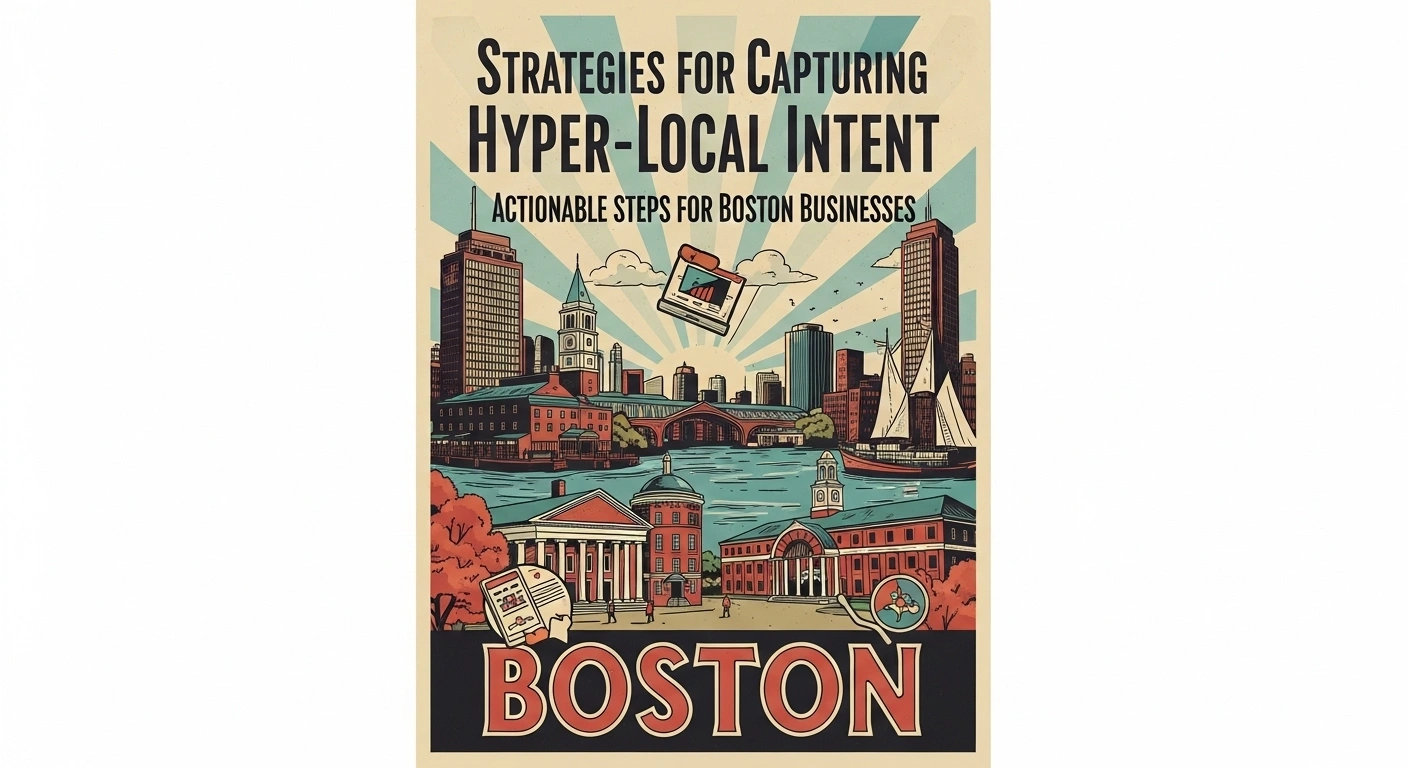
With a deep understanding of intent, it’s time to implement concrete strategies that translate knowledge into market share for your Boston business.
1. Master Your Google Business Profile (GBP) — Again!
We cannot overstate this. Your GBP is the single most powerful tool for capturing local intent. Every element discussed in Post 2 of this series (categories, attributes, services, photos, posts, reviews, Q&A) directly feeds into Google’s ability to understand your business and match it to precise user intent. A complete, verified, and actively managed GBP is your top priority.
2. Content Strategy Aligned with Intent
Develop a content calendar that targets each type of local intent:
- Informational Content: Create blog posts and guides answering local “what,” “where,” and “how-to” questions (e.g., “Best time to see fall foliage near Boston,” “How to find parking in the North End”).
- Transactional Content: Optimize product/service pages with clear CTAs, pricing, and booking options. Ensure your GBP links directly to these conversion pages where appropriate.
- Commercial Investigation Content: Develop comparison guides, detailed service explanations, and robust testimonial sections (e.g., “Why Our Seaport Restaurant is Your Top Choice for Corporate Events,” “Choosing the Right Financial Advisor in Boston: What to Look For”).
- Navigational Content: Ensure your contact page, hours, and directions are easily found on your website and GBP.
Remember that for local intent, Google is looking for content that is not just relevant to the search query, but also to the *physical world* around the searcher. Integrate local landmarks, common Boston phrases, and specific neighborhood details.
3. On-Page SEO for Intent: Speaking Google’s Language
Every element on your website should be intentionally designed to signal your local relevance and intent fulfillment:
- Localized Title Tags and Meta Descriptions: Include your primary local keywords and a compelling value proposition. Make sure these are unique for every relevant page.
- Geo-Specific H1s and Subheadings: Use headings to break down content and incorporate variations of your local keywords (e.g., “Top-Rated Plumbing Services in Beacon Hill” for an H1, with H2s like “Emergency Repairs in Downtown Boston” or “Drain Cleaning in the Back Bay”).
- Body Content Integration: Naturally weave local keywords, landmarks, and relevant local phrases throughout your text. Don’t keyword stuff, but demonstrate comprehensive local context.
- Image Optimization: Use descriptive alt text and file names that include local keywords (e.g., `boston-common-yoga-class.jpg` with `alt=”Outdoor yoga class in Boston Common”`).
- Internal Linking: Build a robust internal linking structure that connects your localized pages. Link from a general “Services” page to specific “Southie Services” pages, or from a blog post about local events to your contact page.
- Mobile Optimization: Ensure your website loads rapidly and is fully responsive on all mobile devices. Core Web Vitals (especially INP) are crucial here.
4. Schema Markup: Giving Google the Direct Answers
Implement structured data (schema markup) to provide explicit signals to Google about your business and its offerings. This is crucial for local SEO and for enhancing your visibility in rich snippets and AI Overviews:
- Local Business Schema: This is fundamental. It explicitly details your business name, address, phone number, hours, reviews, and categories. Ensure it’s correctly implemented on every relevant page, particularly your homepage and contact page.
- Service and Product Schema: For transactional pages, this provides granular details about your services and products, including pricing, availability, and customer reviews.
- FAQPage Schema: For any FAQ sections on your website, this allows Google to display direct answers to user questions, often within the “People Also Ask” section or directly within AI Overviews.
- Review and AggregateRating Schema: Displays star ratings in search results, a powerful visual cue for commercial investigation intent.
5. User Experience (UX) & Engagement Signals
Google’s AI models are increasingly sophisticated at evaluating user engagement as a proxy for intent fulfillment. A positive user experience translates to higher rankings:
- Fast Loading Speed: Optimize images, leverage caching, and minimize code to ensure your site loads quickly, especially on mobile.
- Intuitive Navigation: Make it easy for users to find what they’re looking for. Clear menus, internal search functions, and logical page hierarchy.
- Clear Calls to Action (CTAs): Guide users towards the next step, whether it’s “Call Now,” “Book Online,” “Get Directions,” or “Request a Quote.”
- Engaging Content: Use multimedia (videos, infographics), break up text with headings and bullet points, and write in a clear, concise style to keep users on your page longer. High dwell time and low bounce rates signal content quality and intent fulfillment.
6. Voice Search Optimization: Preparing for the Conversational Future
As voice search becomes more common, optimize for conversational queries:
- Natural Language: Incorporate questions and answers into your content that mimic how people speak.
- Long-Tail Keywords: Voice queries are typically longer and more specific than typed queries.
- Direct Answers: Provide concise, direct answers to common questions, as voice assistants often pull these directly.
7. E-E-A-T and Boston Authenticity: The Ultimate Intent Signal
Ultimately, Google’s AI wants to direct users to the most experienced, expert, authoritative, and trustworthy source. For Boston businesses, this means:
- Showcasing Local Expertise: Highlight your team’s deep knowledge of Boston, its neighborhoods, and its unique challenges. For a construction firm, this might mean showcasing experience with historic Boston brownstones.
- Publishing Original Research/Case Studies: Demonstrate your unique insights with Boston-specific data or success stories.
- Building Local Authority: Engage in the Boston community, earn local links, and garner positive reviews that speak to your authenticity.
- Transparent & Trustworthy: Ensure all your business information is consistent and accurate across every platform.
The more genuinely helpful and authoritative you are, the more confidently Google’s AI will serve your business as the optimal solution for a user’s local intent.
—
Measuring Intent Fulfillment: Beyond Simple Rankings for Boston Businesses
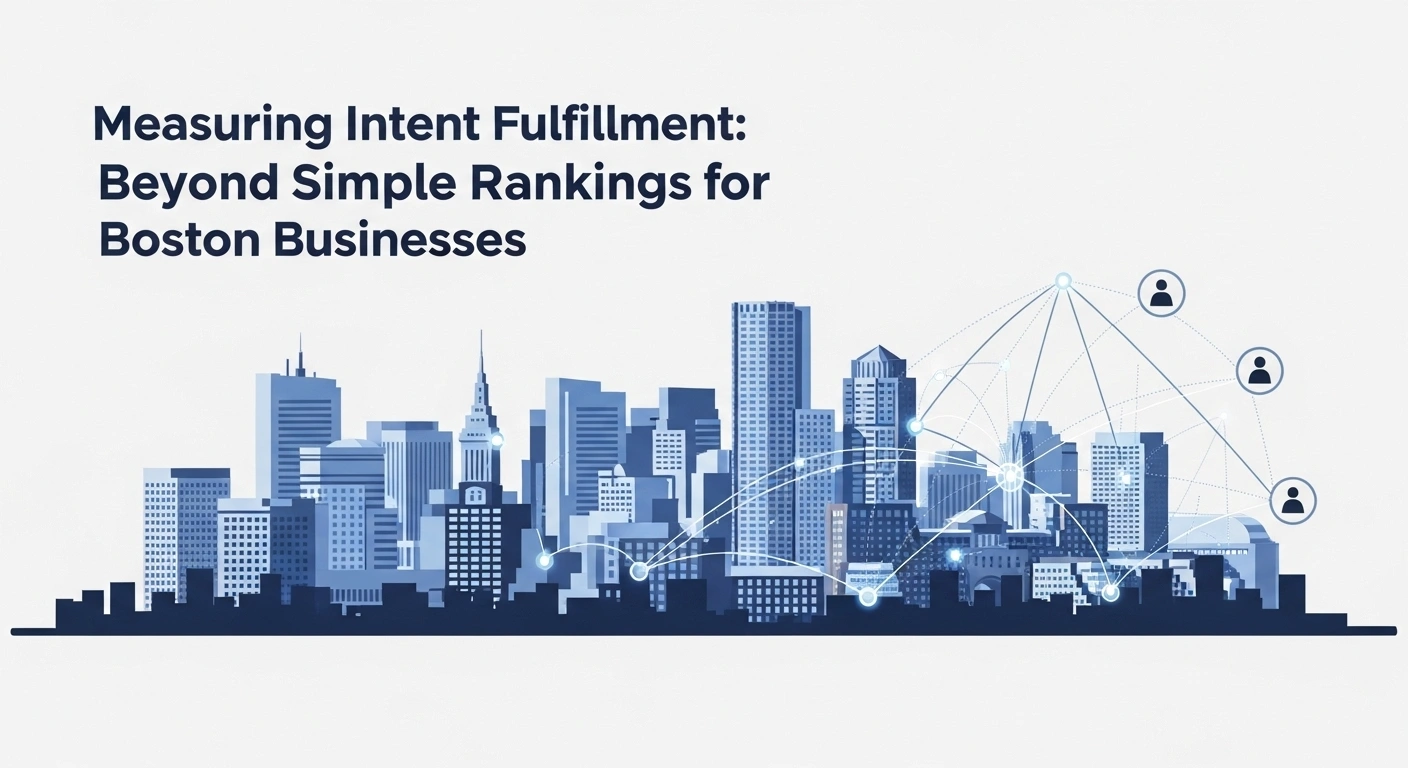
While tracking keyword rankings is important, truly understanding intent fulfillment requires a more nuanced approach to analytics. For Boston businesses, this means looking beyond impressions to conversion-driven metrics.
1. Google Business Profile Insights: Intent-Specific Data
Revisit your GBP Insights (as detailed in Post 2). Specifically, look at:
- Search Queries: This is your direct window into the exact phrases users typed. Analyze these to see if they match your target intents (informational, navigational, transactional, commercial investigation). Look for new or unexpected queries that reveal emerging intent.
- Customer Actions: Track direct calls, direction requests, and website clicks from your GBP. These are strong indicators of transactional intent fulfillment.
- Photo Views and Interactions: High engagement with your visuals often means users are finding the visual information they intended to see.
2. Google Analytics 4 (GA4): Deeper Website Intent Analysis
GA4, with its event-based tracking, provides powerful insights into user behavior on your website, helping you understand if specific content is fulfilling its intended purpose:
- Engaged Sessions: Track sessions where users spend a meaningful amount of time or interact significantly. This indicates informational intent fulfillment.
- Conversions: Set up conversions for phone calls, form submissions, online purchases, or appointment bookings. These directly measure transactional intent fulfillment.
- Page Views & Landing Pages: Identify which local content pages (e.g., specific service area pages, local blog posts) are attracting the most traffic and how users are interacting with them.
- User Flow: Analyze how users navigate your site. Do they move from an informational blog post to a relevant service page? This indicates a successful journey through the intent funnel.
- Geo-Location Data: Segment your audience by city or even neighborhood within Boston to understand intent variations by locale.
3. Search Console: Understanding Google’s Perception of Your Intent
Google Search Console (GSC) is crucial for understanding how Google perceives your content and its intent relevance:
- Performance Report: Analyze queries where your pages appear and their click-through rates (CTR). A high CTR for a specific local query indicates Google sees your page as highly relevant to that intent.
- Coverage Report: Ensure all your relevant local pages are indexed and discoverable by Google.
- Enhancements Report: Check for any issues with schema markup or Core Web Vitals that might hinder your ability to fulfill intent effectively.
—
Conclusion: Mastering Boston’s Hyper-Local Search Intent for Sustainable Growth

In the evolving digital landscape of 2025, where Google’s AI is more sophisticated than ever, merely targeting keywords is a relic of the past. For Boston businesses, true local SEO dominance hinges on a profound understanding and meticulous fulfillment of **hyper-local search intent**. This means looking beyond the words typed into a search bar and discerning the underlying need, context, and desired action of every Bostonian searcher.
By understanding the different types of local intent — informational, navigational, transactional, and commercial investigation — and by strategically crafting your Google Business Profile, website content, and technical SEO elements to directly address each, you transform your online presence from a passive listing into an active, intelligent lead-generation machine. Leveraging advanced AI models, prioritizing E-E-A-T, and constantly analyzing user behavior allows you to speak directly to the nuances of Boston’s diverse neighborhoods and its discerning populace.
Mastering hyper-local search intent ensures that when a potential customer in Boston has a need, your business isn’t just found; it’s the obvious, trusted, and most relevant choice. This is the strategic imperative for not just surviving, but truly flourishing and dominating your market segment in the new economic reality.
This deep dive has equipped you with the knowledge to decode Boston’s search intent. Next, we’ll explore how to physically project your business’s presence into the very neighborhoods your customers inhabit, beyond just your immediate location.
Is your Boston business struggling to connect with high-intent local customers despite a strong online presence? The experts at **seobostonma.com** specialize in advanced local SEO strategies, including deep intent analysis and content optimization, that deliver measurable results for Boston businesses like yours. Schedule a free consultation with our team today and let’s unlock your path to hyper-local dominance.


